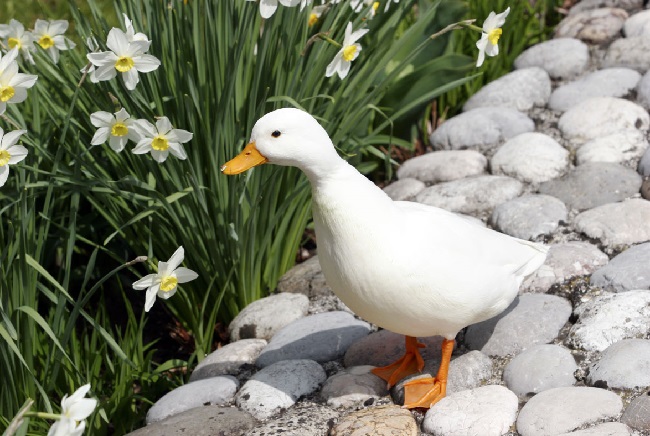White ducks are known for their elegant and pristine appearance. These beautiful birds captivate with their pure white feathers and charming personalities.
In this article, we will explore various breeds of white ducks, providing detailed information about each breed, their characteristics, and what makes them unique.

White Duck Breeds
Here are some of the breeds of white ducks:
Read Also:
Pekin Duck
The Pekin Duck is one of the most popular and recognizable breeds of domestic ducks. They have a distinct white plumage, orange bills, and orange legs.
Pekins are known for their friendly and docile nature, making them suitable for backyard flocks and petting zoos. They are also highly prized for their meat and egg-laying capabilities.
Cayuga Duck
Cayuga Ducks, despite their name, can also display a stunning white plumage. However, their feathers may have iridescent hues of green and purple, giving them a unique appearance.
Cayugas are known for their calm and gentle temperament, making them popular among duck enthusiasts. They are excellent foragers and can adapt well to various climates.
White Crested Duck
As the name suggests, White Crested Ducks are recognized for their distinctive white feathers and a tuft of feathers atop their heads.
This breed is known for its friendly and sociable nature, often interacting well with other duck breeds. White Crested Ducks are a popular choice for exhibitions and shows due to their striking appearance.
Rouen Duck
Rouen Ducks, although primarily known for their mallard-like plumage, can also exhibit white feathers. They have a robust and stocky build, making them larger than many other duck breeds.
Rouen are often kept for their ornamental value and as exhibition birds due to their beautiful markings and overall size.
Indian Runner Duck
Indian Runner Ducks come in various colors, including white. They are recognized for their upright posture and distinctive running gait. Indian Runners are prolific layers, producing a large number of eggs each year.
They have a slender body shape and a curious and active nature, making them popular choices for both egg production and as entertaining backyard pets.
Swedish Duck
Swedish Ducks, also known as Blue Swedish Ducks, can occasionally display white feathers. These ducks have a striking appearance, with a mix of blue and white plumage.
They are calm, friendly, and hardy birds, known for their ability to adapt well to different environments. Swedish Ducks are excellent foragers and make great additions to backyard flocks.
Caring for White Ducks: Considerations and Tips
Here are some of the caring tips for white ducks:
Housing and Space Requirements
White ducks, like any other duck breed, require proper housing and ample space to thrive. Ensure that their enclosure is secure, predator-proof, and provides protection from the elements. Ducks need enough space to roam and access to water for swimming and bathing.
Feeding and Nutrition
White ducks have similar dietary needs to other duck breeds. A balanced diet should consist of a quality waterfowl feed that provides essential nutrients, vitamins, and minerals.
It’s also beneficial to offer fresh greens, vegetables, and occasional treats such as mealworms or cracked corn. Ensure access to clean drinking water at all times.
Socialization and Interaction
Ducks, including white ducks, are social animals that thrive in the company of their own kind. Consider keeping a small flock rather than having a single duck.
Ducks enjoy interacting with each other and benefit from socialization. However, ensure that the flock is properly introduced to avoid any territorial conflicts.
Health Care and Regular Check-ups
White ducks, like all ducks, require regular health care to ensure their well-being. This includes routine check-ups, vaccinations (if necessary), and preventive measures against common duck ailments such as parasites and diseases.
Consult with a veterinarian experienced in avian care for guidance on maintaining the health of your white ducks.
Environmental Enrichment
White ducks, like other ducks, can benefit from environmental enrichment. Provide them with opportunities to engage in natural behaviors such as foraging, swimming, and exploring.
Scatter food in the grass or use puzzle feeders to stimulate their foraging instincts. Additionally, providing a shallow pool or pond for swimming is essential for their physical and mental well-being.
Predation Prevention
White ducks are vulnerable to predation, so it’s crucial to take steps to protect them. Secure their enclosure with sturdy fencing and use wire mesh to prevent entry by predators such as raccoons or foxes. Provide shelter and a safe space for them to retreat to if they sense danger.
Monitoring and Observation
Regular monitoring and observation of your white ducks are essential to detect any signs of illness or abnormal behavior. Watch for changes in appetite, droppings, feather condition, or any signs of distress.
Early detection of health issues can prevent more significant problems and ensure prompt veterinary care if needed.
Responsible Breeding Practices
If you plan to breed white ducks, it is crucial to engage in responsible breeding practices. Ensure that both the male and female ducks are healthy and of appropriate age.
Provide appropriate nesting areas and monitor the breeding process closely. Seek guidance from experienced breeders or avian professionals to ensure a successful breeding program.
Read Also:
Conclusion
White ducks encompass a diverse range of breeds, each with its own unique characteristics and appeal. From the iconic Pekin Ducks to the elegant Cayugas, these birds bring beauty, charm, and often practicality to those who keep them.
Whether you are looking for a friendly and sociable companion or a prolific egg layer, there is a white duck breed to suit your needs.
However, it’s important to consider the specific requirements of each breed and provide appropriate care to ensure their health and well-being.
























